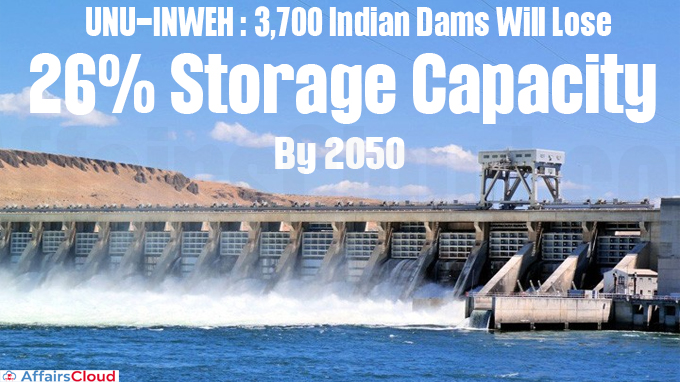 According to a new study by the United Nations University Institute for Water, Environment, and Health (UNU-INWEH), around 3,700 large dams in India could lose on average 26% of their initial total storage by 2050 owing to sediment deposition, which might affect future water security, irrigation, and power generation.
According to a new study by the United Nations University Institute for Water, Environment, and Health (UNU-INWEH), around 3,700 large dams in India could lose on average 26% of their initial total storage by 2050 owing to sediment deposition, which might affect future water security, irrigation, and power generation.
- The findings were originally published in the journal ‘Sustainability’ in an article titled “Present and Future Losses of Storage in Large Reservoirs Due to Sedimentation: A Country-Wise Global Assessment” by the UNU-INWEH.
Click here to access the report
Note: In 2015, the Central Water Commission (CWC) revealed that one-quarter of the 141 large reservoirs over 50 years old had lost at least 30% of their initial storage capacity.
UNU-INWEH Study: The Global Scenario
i.Due to sediment trapped in dams, about 50,000 large dams around the world will lose 24-28% of their water storage capacity by 2050.
- These reservoirs have already lost 13%-19% of their capacity due to sedimentation.
- Sedimentation occurs when a river carrying eroded soil is blocked by a dam at its watershed.
- The combined annual water demand of India, China, Canada, Indonesia, and France is equal to the estimated actual capacity loss of about 1,650 billion cubic metres.
ii.The researchers estimated the storage capacity losses of 47,403 large dams in 150 countries based on their present storage-loss rates, which will fall to 4,665 billion cubic metres by 2050, resulting in a 26% storage loss.
- These include 10,358 in North, Central, and South America; 2,349 in Africa; 6,651 in Europe; 28,045 in the Asia-Pacific (APAC) and 10,358 in Africa.
iii.China, the country with the most dams in the world, has already lost nearly 10% of its storage and will lose an additional 10% by 2050.
iv.By 2050, the water storage capacities of the United Kingdom (UK), Panama, Ireland, Japan, and Seychelles will have decreased by 35% to 50%.
v.Bhutan, Cambodia, Ethiopia, Guinea, and Niger will be the 5 least impacted nations by 2050, with losses of less than 15%.
vi.The Asia-Pacific (APAC) region, which is home to the majority of the world’s dams, is estimated to have lost 13% of its initial dam storage capacity by 2022.
- It will have lost about a quarter (23%) of its initial storage capacity by 2050.
APAC is home to 60% of the world’s population, and water storage is essential to ensure water and food security.
vii.The 3,052 dams in Japan, with an average age of over 100 years, have the greatest loss of storage capacity in the region.
- They have already lost 39% of their total initial storage capacity, and by 2050, they will have lost on average close to 50% and in some cases 67% of it.
viii.According to the study, by 2050, the 10,358 large dams in the Americas will only be able to store 2,014 billion cubic metres, or 28% of their original capacity.
ix.In addition, Europe’s 6,651 large dams spread across 42 countries will lose 28% of their initial capacity of 895 billion cubic metres.
x.By 2050, it is anticipated that the 2,349 dams spread across the 44 countries in Africa will lose 24% of their storage capacity.
Recent related news:
The World Meteorological Organization (WMO) has published its first ‘State of Global Water Resources Report 2021’, which examines the effects of climate, environmental, and societal change on the Earth’s water resources.
The purpose of this annual report is to aid in the oversight and management of the world’s freshwater resources in a time of rising demand and limited supplies.
About United Nations University Institute for Water, Environment, and Health (UNU-INWEH):
UNU-INWEH, also known as the UN’s ‘Think Tank on Water’, is one of the UNU institutes and an academic arm of the United Nations (UN).
Director – Vladimir Smakhtin
Established – 1996




